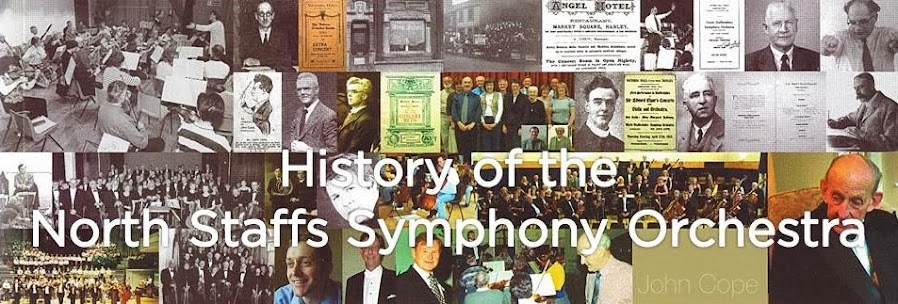A humble start
The North Staffordshire Symphony Orchestra began life in humble surroundings, in Burslem, Stoke-on-Trent. But where exactly?
Legend has it that the young John Cope, from Milton, started rehearsing his new orchestra in 1904 in a 'draughty timber merchant's shed'.
Until 2023, nobody knew the exact location of the merchant's wood shed, if it existed at all. But, by chance in October 2023, a map of Burslem, dated 1879, was found online. And after a quick search - there it is - the timber merchant!
 |
| Burslem Ordnance Survey Map - published 1879 Map reproduced with the permission of the National Library of Scotland (Click on image to enlarge) |
The map quite clearly shows a 'Timber Yard' in Moorland Road, Burslem, close to Beethoven House, (now No.76, just up the road) the home of Madame Marie Reymond (Cope's teacher, mentor and source of funds). The timber yard appears to be just where the Queen's Theatre (originally the New Town Hall) now stands.
Could this be where the orchestra was born nearly 120 years ago? One of the oldest symphony orchestras in the world. My guess is that it is!
The map image is the Burslem Ordnance Survey Map - published 1879. Reproduced with the permission of the National Library of Scotland. https://maps.nls.uk/view/101595905#zoom=6&lat=5902&lon=2263&layers=BT
A Talent and a Mentor
The orchestra was formed by the young and talented musician, John Cope. Cope had recently returned to the Potteries from Munich where he had been studying the organ with Rheinberger and was then encouraged to establish the orchestra by his former teacher and mentor, Madame Marie Reymond.
 |
| Madame Marie Reymond and John Cope |
The orchestra was given the name of The Potteries Orchestral Society and drew amateur musicians from miles around the district. Cope was a task master and instilled on the members of the orchestra the disciplines so necessary for the enterprise. Players were worked hard but they began to love what Cope was beginning to achieve.
The orchestra's first concert was held in the Old Town Hall (built 1852-7) in Burslem in 1904. But the audience was small.
Choral singing at the time was a very strong tradition in The Potteries and the launch of a new purely orchestral music society was thought of as something superfluous. In fact many local choirs shunned the orchestra and Cope was often ridiculed by fellow choir masters. Cope and his orchestra persevered and carried on.
In 1906 the orchestra changed its name to The North Staffordshire Orchestral Society and its first concert given in Hanley was in the Victoria Hall on November 1st. Although local interest was again poor, support did come from further afield and Sir Granville Bantock and Ernest Newman of Birmingham were very keen to see the orchestra succeed. Newman attended the concert and was delighted with the performance of the Mendelssohn Violin Concerto with Lady Halle as soloist. The concert also included Sibelius's newly composed Finlandia.
In 1907 the name was changed again, this time to The North Staffordshire Orchestra and yet again in 1909 to The North Staffordshire Symphony Orchestra.
A Mentor and a Patron
During those early years Madame Reymond was a major patron and supporter of the orchestra. She was successful in persuading none other than Sibelius to become a fellow Patron. She had come to North Staffordshire from Denmark in 1887 and set up a private music school at Beethoven House in Moorland Road, Burslem. It was here that she first spotted Cope and encouraged his musical talent. She helped to manage the orchestra and indeed funded it by carrying much of its costs. As today there was no profit in classical music making, only losses.By 1919 her personal funds ran out and Madame Reymond was forced to withdraw her support. There is no doubt that we owe a debt of gratitude to the lady who helped the birth of the NSSO. She died in 1926.
The orchestra continued to grow in stature under Cope's direction until in 1954 at its Jubilee concert he decided to retire. He died at his home in Charles Street, Hanley in April 1962 and was buried in the same grave as Marie Reymond in Hanley cemetery.
Mother Town Marvels
To celebrate the founding of the NSSO in Burslem - known as 'The Mother Town' of the Potteries - a Facebook group called Our Burslem created and fixed window vinyls to shop windows in Queen Street. Here's what they look like.
Many thanks go to Annette Francis and Our Burslem (Facebook) for the creation of the NSSO's Mother Town Marvels.
What else happened in 1904?
- The London Symphony Orchestra, just like the NSSO, gave its first concert
- The Abbey Theatre in Dublin opened
- Ice cream cone makes its debut
- Sir Cecil Beaton, photographer, was born. His knighthood came later!
- Salvador Dalí, Spanish artist, was born
- The first mainline electric train in Britain ran from Liverpool to Southport
- Sir John Gielgood, actor, was born in London
- The first attempts at talking pictures were made at Fulham Theatre
- Henry Royce built his first car
- Ford Model B was an upscale touring car introduced.
- George Formby, entertainer, was born
- Three thousand London cab drivers went on strike
- Graham Greene, novelist, was born
- The first underwater voyage of a submarine was made
- The London Coliseum opened
- An ultra violet lamp was made
- Work on the Panama Canal started
- Charles Rennie Macintosh, Scottish architect, designed the Willow Tea Rooms
- The Daily Mirror was founded
- It was a leap year!
- Edward Elgar was knighted
- First performance of Edward Elgar's "In the South (Alassio)"
- Delius wrote Koanga
- Dvorak died
- Bela Bartok's symphony "Kossuth" premieres
- Giacomo Puccini's opera "Madama Butterfly" premieres in Milan
- Gustav Mahler's 5th symphony premieres in Cologne
- Eduard Lassen, composer, dies at 73






